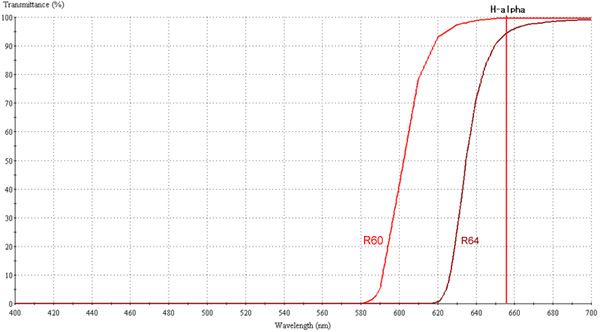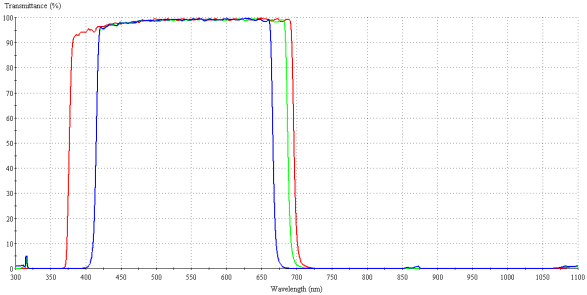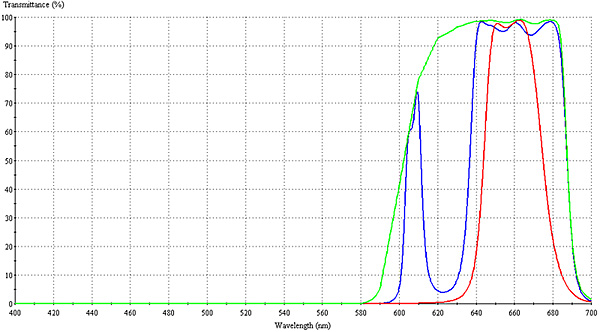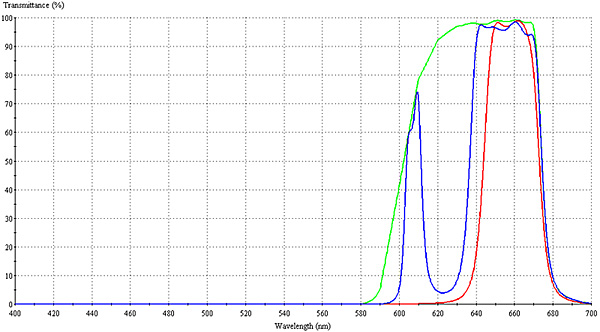Equipment for the Serious Amateur Astronomer
|
|
Hutech Astronomical Products
Equipment for the Serious Amateur Astronomer |
|
|
|||||||||||
|
|
|
||||||||||
Economical H-Alpha Imaging to Improve Image ContrastMany dynamic and interesting astronomical objects glow predominantly in the light of ionized hydrogen. Of particular interest to astrophotographers is the hydrogen-alpha (Hα) emission line at 656.28 nanometers, deep in the red end of the visible light spectrum. Photos taken through filters which isolate this emission line show subtle details which are normally of such low contrast that they are obscured by the broadband light emitted by stars and man-made light pollution, especially from the strongly scattered blue end of the spectrum. The Hα monochromatic image can be used as a luminance channel and combined with a full-spectrum image. This combined image enhances the fine details lost in a conventional color image. The best way to improve the Hα feature contrast is to use a very narrow-band filter (typically around 5-15nm). But a major problem is that the cost of such a narrow-band filter is very high, especially for large imaging sensors. However, we can still get the benefits of improved contrast by combining several less expensive filters to limit the amount of contrast-reducing broadband light which reaches the imaging sensor. For example, when using a spectrum-enhanced DSLR with IDAS astronomical bandpass filter, one can add a deep red filter such as a Kenko R64 or R1(R60) filter. The R1(R60) filter is preferrable to allow the highest Hα line transmission. In conjunction with the IDAS astronomical filter installed in the spectrum-enhanced DSLR, only red light, including the Hα emission line, is allowed to reach the sensor. The IDAS astronomical filter acts to filter out the near-IR component of the image which passes through the Kenko 'R' filter.  Kenko 'R' filter response plots.  IDAS Astronomical Bandpass filter plots for various enhanced spectrum Canon DSLR models: Red: Type I for 300D/20D Green: Type Ia for 350D/30D/5D Blue: Type Ib for 400D To further narrow the bandpass in the Hα region, an IDAS light pollution suppression filter (LPS-P2) or nebula filter (LPS-V3) can be added to the stack. Plots for the filter stack combinations are shown below (Canon 350D/30D/5D at top, Canon 400D at bottom):

Filter stack plots for spectrum-enhanced Canon 350D/30D/5D (with type Ia filter): Green: R1(R60) only Blue: R1(R60) + LPS-P2 Red: R1(R60) + LPS-V3

Filter stack plots for spectrum-enhanced Canon 400D (with type Ib filter): Green: R1(R60) only Blue: R1(R60) + LPS-P2 Red: R1(R60) + LPS-V3 |
|||||||||||
|
|
|||||||||||